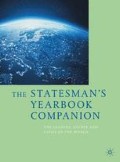You have full access to this open access chapter, Download reference work entry PDF
Introduction
Pushpa Kamal Dahal was voted prime minister for the second time on 3 Aug. 2016 following the resignation of K. P. Oli. He previously held office from Aug. 2008 to May 2009 as head of a coalition government, following many years as leader of the military wing of the Communist Party of Nepal (Maoist), later renamed the Unified Communist Party of Nepal (Maoist) and now called the Communist Party of Nepal (Maoist-Centre). Known as Prachanda (‘The fierce one’), he led a Maoist insurgency from Feb. 1996 until Nov. 2006.
Early Life
Prachanda was born on 11 Dec. 1954 in central Nepal to a poor farming family. In 1966 his family moved to Chitwan district, where he was introduced to communism. He graduated from the Institute of Agriculture and Animal Science in Rampur, Chitwan, in 1975. He briefly taught in a primary school before becoming active in the Communist Party of Nepal. The party underwent a series of splits, during which Prachanda joined the CPN (Mashal) wing. He became a member of the politburo, rising to the post of general secretary in 1989.
Following the popular uprising that forced King Birendra to relinquish absolute power and form a constitutional government in 1990, several radical parties merged to become the Communist Party of Nepal (Unity Centre), with Prachanda as general secretary. In 1995, following splits within the party, he renamed his wing the Communist Party of Nepal (Maoist)—known as CPN (M)—and developed the ‘Prachanda Path’. A plan that combined the Maoist rural-based theory of revolution with the Marxist–Leninist urban-based approach. It proposed to establish a people’s republic, to redistribute property and to dismantle existing patterns of capital and ownership, particularly those that gave economic control to Indian interests. Prachanda took command of the CPN (M)’s military wing, with the political wing headed by Dr Baburum Bhatterai.
In early 1996 Prachanda presented the government with a list of demands including the abolition of the monarchy and redistribution of land. When these were rejected he launched an insurgency, beginning a civil war that lasted for 10 years and resulted in 13,000 deaths. Prachanda spent the period in hiding, living in India for much of the time despite having identified it as an enemy of the Nepalese people. CPN (M) militia established control over many rural areas and in Nov. 2005, following King Gyanendra’s resumption of absolute rule, Prachanda led the CPN (M) into an alliance with Nepal’s mainstream political parties. After public unrest forced King Gyanendra to restore parliament in 2006, Prachanda entered negotiations with the government and signed a comprehensive peace agreement in Nov. of that year. His party won national elections in April 2008 but without an overall majority.
In Aug. 2008, 2 months after the monarchy was abolished, Prachanda was elected prime minister by an alliance consisting of the CPN (M) and several smaller groups, on a promise of radical reforms. However, his government struggled to tackle endemic poverty, rising food prices and fuel shortages, and was criticized for alleged human rights abuses and suppression of the press. In May 2009 Prachanda sought to dismiss the chief of the army over attempts to integrate former Maoist rebel fighters into the army but the dismissal was revoked by the president. Prachanda announced his resignation the following day.
In the 2013 parliamentary election, Prachanda was surprisingly defeated while defending his Kathmandu-10 constituency but won Siraha-5, the second constituency he was contesting, by a narrow margin. From 2013 he was heavily involved in the drawing up and promulgation of the new constitution that came into effect on 20 Sept. 2015. Following K. P. Oli’s resignation in July 2016, Prachanda’s candidacy for a second term as prime minister was announced with backing from the Nepali Congress and Madhesi Front coalition. On 3 Aug. Prachanda received 363 of the 573 votes cast in the 595-seat parliament. He was the only candidate.
Career Peak
Prachanda’s main challenges were promoting economic development and bridging the ethnic divides brought about by the new constitution that redefined the boundaries of the country’s provinces. He resigned in May 2017, with Sher Bahadur Deuba of the Nepali Congress assuming the premiership the following month in accordance with an agreement reached in 2016 between the two leaders.
Copyright information
© 2019 Springer Nature Limited
About this entry
Cite this entry
(2019). Dahal, Pushpa Kamal ‘Prachanda’ (Nepal). In: The Statesman’s Yearbook Companion. Palgrave Macmillan, London. https://doi.org/10.1057/978-1-349-95839-9_176
Download citation
DOI: https://doi.org/10.1057/978-1-349-95839-9_176
Published:
Publisher Name: Palgrave Macmillan, London
Print ISBN: 978-1-349-95838-2
Online ISBN: 978-1-349-95839-9
eBook Packages: Political Science and International StudiesReference Module Humanities and Social SciencesReference Module Business, Economics and Social Sciences

